Baulne-en-Brie | |
|---|---|
Part of Vallées-en-Champagne | |
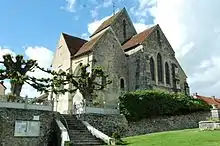 | |
Location of Baulne-en-Brie | |
 Baulne-en-Brie 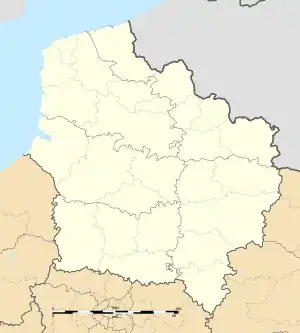 Baulne-en-Brie | |
| Coordinates: 48°59′16″N 3°36′53″E / 48.9878°N 3.6147°E | |
| Country | France |
| Region | Hauts-de-France |
| Department | Aisne |
| Arrondissement | Château-Thierry |
| Canton | Condé-en-Brie |
| Commune | Vallées-en-Champagne |
| Area 1 | 18.89 km2 (7.29 sq mi) |
| Population (2021)[1] | 289 |
| • Density | 15/km2 (40/sq mi) |
| Time zone | UTC+01:00 (CET) |
| • Summer (DST) | UTC+02:00 (CEST) |
| Postal code | 02330 |
| Elevation | 82–243 m (269–797 ft) (avg. 100 m or 330 ft) |
| 1 French Land Register data, which excludes lakes, ponds, glaciers > 1 km2 (0.386 sq mi or 247 acres) and river estuaries. | |
Baulne-en-Brie (French pronunciation: [bo(l)n ɑ̃ bʁi], literally Baulne in Brie) is a former commune in the department of Aisne in northern France. On 1 January 2016, it was merged into the new commune Vallées-en-Champagne, of which it is a delegated commune.[2][3]
Geography
Baulne-en-Brie is located some 15 km east by south-east of Château-Thierry and 20 km west by south-west of Épernay. It can be accessed by the D4 road from Condé-en-Brie in the west through the heart of the commune and the village and continuing east to Le Breuil. There is also a country road from La Chapelle-Monthodon in the north. The south-eastern border of the commune is part of the border between the departments of Aisne and Marne. There are three hamlets in the commune other than the village: Montchevret, Grande Fontaine, and Romandie. There are extensive forests in the north, centre, south-east and south of the commune with the rest of the area being farmland.[4]
The Verdonnelle stream flows north-west through the southern part of the commune passing near the hamlet of Romandie and continuing north-west out of the commune. The Surmelin stream flows from the south-east passing through the village and continuing north-west to join the Marne near Mézy-Moulins.[4]
Neighbouring communes and villages
Administration
List of Successive Mayors of Baulne-en-Brie[5]
| From | To | Name | Party |
|---|---|---|---|
| 2001 | 2008 | Gilles Hiernard | DVD |
| 2008 | 2016 | Bruno Lahouati |
Demography
|
| ||||||||||||||||||||||||||||||||||||||||||||||||||||||||||||||||||||||||||||||||||||||||||||||||||||||||||||||||||
| Source: EHESS[6] and INSEE[7][1] | |||||||||||||||||||||||||||||||||||||||||||||||||||||||||||||||||||||||||||||||||||||||||||||||||||||||||||||||||||
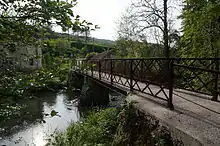
Economy
Baulne-en-Brie is an agricultural and wine-producing village and a part of the Appellation d'origine contrôlée (AOC) zone for "Champagne of Aisne".
Culture and heritage
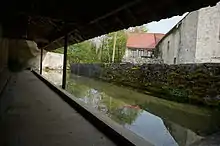
Civil heritage
The commune has two sites that are registered as historical monuments:
- Other sites of interest
- The Place Daniel Beaucreux in front of the church. In memory of the men and women of the Canton of Condé-en-Brie and the region who experienced deportation and death in the Nazi concentration camps. Marked: "Dead in Deportation, alive in our memories".
- A Lavoir (Public laundry) in the main street has been decorated on the theme of the fable "The dairy and milk jug".
- Little Switzerland of Condé, the area around the hamlet of Romandie, gives access to the Verdonnelle valley.
- A Directional table opposite the Chemin de Glapiers on the road to Saint-Agnan offers an outstanding view of the Surmelin valley.
Religious heritage

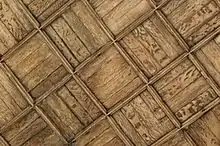
The commune has several religious buildings and structures that are registered as historical monuments:
- The Church of Saint Bartholomew (12th century).
 [10] It has one of the last wooden ceilings with alternating grain slats in the world. The Church contains three items that are registered as historical objects:
[10] It has one of the last wooden ceilings with alternating grain slats in the world. The Church contains three items that are registered as historical objects:
See also
References
- 1 2 "Populations légales 2021" [Legal populations 2021] (PDF) (in French). INSEE. December 2023.
- ↑ Arrêté préfectoral 23 November 2015 (in French)
- ↑ Commune de Baulne-en-Brie (02053), INSEE
- 1 2 3 Google Maps
- ↑ List of Mayors of France (in French)
- ↑ Des villages de Cassini aux communes d'aujourd'hui: Commune data sheet Baulne-en-Brie, EHESS (in French).
- ↑ Populations légales 2012, INSEE
- ↑ Ministry of Culture, Mérimée IA02001301 Madame Max Park (in French)
- ↑ Ministry of Culture, Mérimée IA02001300 Chateau Park (in French)
- ↑ Ministry of Culture, Mérimée PA00115519 Church of Saint Bartholomew (in French)

- ↑ Ministry of Culture, Palissy PM02000071 Funeral Plaque of Madeleine de Castellan, widow of Louis Mallart, Counsellor to the King (in French)
- ↑ Ministry of Culture, Palissy PM02000070 Tombstone of Guillaume de Baulne (in French)

- ↑ Ministry of Culture, Palissy PM02000069 Pulpit with 3 Bas-reliefs (in French)

External links
- Baulne-en-Brie on the old National Geographic Institute website (in French)
- Baulne-en-Brie on the Union for initiative of the canton of Condé-en-Brie official website (in French)
- Baulne-en-Brie official website (in French)
- The Prison Door from La Petite Roquette prison (in French)